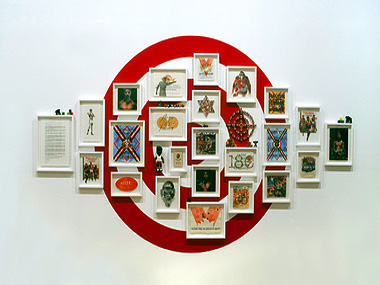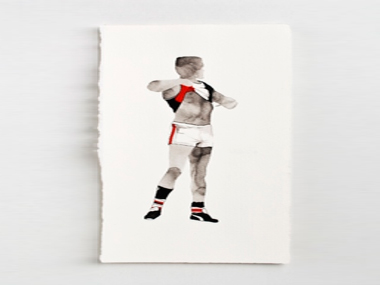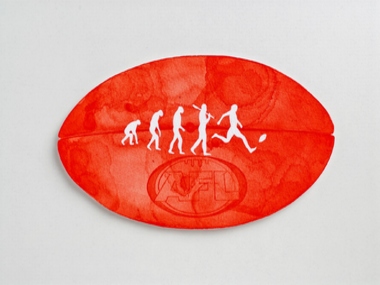LIFE IMITATES ART IMITATES ART AT SELLERS PRIZE

'Once upon a Time', (2014), Tony Albert's entry into the Basil Sellers Art Prize
Posted by Jeremy Eccles | 25.07.14
Gallery: Ian Potter Museum of Art - The University of Melbourne
Dates:
22.07.14
: 26.10.14
Announced tomorrow is the lucky winner of the $100,000 Basil Sellers Art Prize for a work or works which confront issues and themes in sport. As an enthusiastic press release puts it: “From fandom to fanaticism, motivation to morality, and rules to racism, the finalists explore the many facets of sport and examine the parallels between the awe of art and the spectacle of sport”.
And the finalists – currently displayed at an exhibition in The Potter Museum of Art at the University of Melbourne – are:
Tony Albert, Narelle Autio, Zoe Croggon, Gabrielle de Vietri, IvanDurrant, Shaun Gladwell, Richard Lewer, William Mackinnon, Rob McHaffie, Noel McKenna, Rob McLeish, Fiona McMonagle, Raquel Ormella, Khaled Sabsabi, Jenny Watson, and Gerry Wedd.
The judges for both this Prize and the $50,000 National Sports Museum Basil Sellers Creative Arts Fellowship are:
Liz Ann Macgregor OBE, Director of the Museum of Contemporary Art; Kelly Gellatly, Director of the Ian Potter Museum of Art; Robert Cook, curator of contemporary photography and design at the Art Gallery of Western Australia; Michael Hawker AM, distinguished businessman and a veteran of 25 Australian rugby test matches, now Chairman of Australian Rugby Union; Dr Chris McAuliffe, consultant for the Basil Sellers Group; and Basil Sellers AM himself.
Previous winners of the prestigious prize, which is running biennially for 10 years, were Daniel Crooks in 2008, Tarryn Gill and Pilar Mata Dupont in 2010, and Jon Campbell in 2012.
One artist who didn't expect to be even accepted as a finalist this year was Tony Albert. For the Queensland Indigenous artist suspected that the sporty Prize would not be seriously interested in confronting racism – the perennial matter of his art. But, just as news came through that he'd misjudged the judges, so Adam Goodes, legendary Sydney Swans footballer and the subject of Albert's work for the Prize, was announced as Australian of the Year – a fine quinella.
So, life looked up for Tony Albert. But the pendulum swung even as 'Once upon a time' was being made. The key art influence on Albert's young life – fellow-Queensland artist, Gordon Bennett – unexpectedly died. And Albert had incorporated him into both his art practice generally and this current Sherrin-shaped assemblage of small artworks. For, just as Bennett himself had taken a major step in his work by appropriating the art of Jean-Michel Basquiat, the Black American artist, and writing a public letter to him in 1998 explaining his practice and motives; so Tony Albert wrote to Bennett – not once but twice.
In the first, formal letter in 2010, there were cross—references between the two artists' letters. For Albert was appropriating Bennett's 1994 work 'Daddy's Little Girl' in order to win the approval of the elders of the proppaNOW art group in an angry show called 'The Big See' (as in C for C..t) in reference to rugby league coach Andrew Johns calling a player by that epithet. Albert chose to show a little blonde lass winning Daddy's approval by building a spelling-brick wall declaiming 'Abo, Boong, Coon, Darkie'. “I'm not quoting you to gain greater recognition for myself”, Albert assured his hero, “but to honour your message”.
Gordon Bennett had similarly assured (the already-dead) Basquiat: “(This) may seem very tacky and an attempt to gain some kind of attention, even 'steal' your crown. That is not my intention. My intention is to highlight the similarities and cross-connections of our shared experience as human beings”.
In today's more intimate letter to the now-dead Bennett, Albert backgrounds the Southern football ethos in which the man who will be Australian of the Year could be cat-called an ape by a little girl in the stands at a Collingwood/Sydney match, the Collingwood Chairman could apologise, but then go on radio and associate Goodes with King Kong! And Eddie McGuire's board refused to accept his offer to resign. “How could he be absolved?” demands Albert – 20 years after the illustrious Nicky Winmar made history by baring his Black chest at a footy match when he was similarly abused.
The 25 panel work raises all these issues too in ape, Ugly Duckling and Albert's own Target imagery, along with texts declaring 'Racism stops with me'. Clearly Goodes, Winmar, Michael O'Loughlin and Gordon Bennett together “all inspire (the artist) to stand against the challenges I face as a Blak man”.
Will they inspire the judges tomorrow?
And the answer is YES!
Tony Albert was the winner, taking home the $100,000 Basil Sellers Prize.
Here's what the judges thought:
“The winning work, Once upon a time deals with the ongoing issue of racism in sport, and by implication, Australian society more broadly, and has at its heart the recent controversy surrounding the crowd abuse directed towards AFL player Adam Goodes (Goodes plays for the Sydney Swans, is a dual Brownlow medallist, and is the 2014 Australian of the Year). Within the suite of intimately scaled works comprising the overall installation is a delicate watercolour of the now iconic moment in 1993 when former Kilda footballer Nicky Winmar lifted his guernsey and pointed proudly at this black skin after enduring racial abuse during a match against Collingwood. The separation of these two incidents by over 20 years, along with the collective imagery of Albert’s playful, yet deceptively powerful work, highlights the fact that as a society, we have a long way to go in both confronting and dealing with these issues.
“Judges commended Once upon a time for its bravery and poetry, and for the fact that it tackles such a difficult and emotive issue in sport and Australian culture without being didactic or heavy-handed. The work is neither a lesson nor a sermon, and provides no answers, but instead creates a contemplative space that encourages the audience to think about these issues in a way that engenders a sense of hope, and of the possibility of change. It also highlights the way in which sport can be a positive forum in which to both air and tackle difficult subjects. Issues such as racism will no doubt continue to arise and to confront, but the very public nature of sport ensures that it provides a platform on which to air, discuss and debate these issues rather than pretend that they don’t exist.”
URL: http://www.sellersartprize.com.au
Share this:
»  del.icio.us
»
del.icio.us
»  Digg it
»
Digg it
»  reddit
»
reddit
»  Google
»
Google
»  StumbleUpon
»
StumbleUpon
»  Technorati
»
Technorati
»  Facebook
Facebook
Contact Details
Gallery: Ian Potter Museum of Art - The University of Melbourne
Email: potter-info@unimelb.edu.au
Telephone: +61 3 8344 5148
Address: Swanston Street Parkville Melbourne 3010 Victoria
Gallery: Ian Potter Museum of Art - The University of Melbourne
Email: potter-info@unimelb.edu.au
Telephone: +61 3 8344 5148
Address: Swanston Street Parkville Melbourne 3010 Victoria

Tony Albert recaptures the moment when Nici Winmar became an Aboriginal icon

Progression from ape to footballer as observed by Tony Albert
Where is the exhibition?
Further Research
Gallery: Ian Potter Museum of Art - The University of Melbourne
Artists: Gordon Bennett | Tony Albert
News Tags: Adam Goodes | Basil Sellers Art Prize | Gordon Bennett | Ian Potter Museum | Jeremy Eccles | Tony Albert
News Categories: Art Prize | Australia | Blog | Event | Exhibition | Industry | News
Exhibition Archive
- 10.10.17 | TARNANTHI 2017
- 11.08.17 | Natsiaas 2017
- 20.07.17 | APY ART DOMINATES THE WYNNE
- 17.07.17 | Anangu Artist Wins $100,000 Prize
- 14.07.17 | The End of AAMU
- 11.07.17 | ART ACROSS THE COUNTRY
- 11.07.17 | TARNANTHI IN OCTOBER
- 05.07.17 | TJUNGUṈUTJA - from having come together
- 13.06.17 | Ghost-Nets Straddle the World
- 07.06.17 | Grayson Perry Going Indigenous?
- 05.06.17 | Barks Bigger than Ben Hur
- 27.05.17 | NGA QUINQUENNIAL 2017
- 21.05.17 | Blak Douglas Finds Home at the NGA
- 21.05.17 | BRIAN ROBINSON WINS HAZELHURST WOP
- 18.05.17 | PARRTJIMA 2.0
Advertising

